
Yoros Castle
Encyclopedia
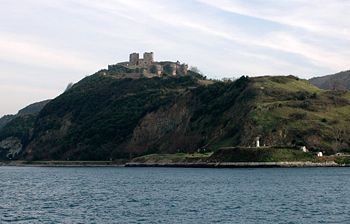
Black Sea
The Black Sea is bounded by Europe, Anatolia and the Caucasus and is ultimately connected to the Atlantic Ocean via the Mediterranean and the Aegean seas and various straits. The Bosphorus strait connects it to the Sea of Marmara, and the strait of the Dardanelles connects that sea to the Aegean...
, to the north of Joshua's Hill
Joshua's Hill
Joshua's Hill , a hill located on the Asian shore of Bosporus in Beykoz district of Istanbul, Turkey is a shrine containing a mosque and a tomb dedicated to Saint Joshua . The sacred place, culminating the height of 180-195 meters above sea level, is also an important landmark for vessels coming...
, in Istanbul
Istanbul
Istanbul , historically known as Byzantium and Constantinople , is the largest city of Turkey. Istanbul metropolitan province had 13.26 million people living in it as of December, 2010, which is 18% of Turkey's population and the 3rd largest metropolitan area in Europe after London and...
, Turkey
Turkey
Turkey , known officially as the Republic of Turkey , is a Eurasian country located in Western Asia and in East Thrace in Southeastern Europe...
. It is also commonly referred to as the Genoese Castle, due to Genoa
Republic of Genoa
The Most Serene Republic of Genoa |Ligurian]]: Repúbrica de Zêna) was an independent state from 1005 to 1797 in Liguria on the northwestern Italian coast, as well as Corsica from 1347 to 1768, and numerous other territories throughout the Mediterranean....
’s possession of it in the mid-15th century.
Geography
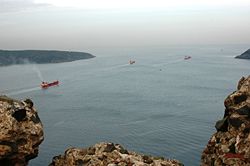
Bosporus
The Bosphorus or Bosporus , also known as the Istanbul Strait , is a strait that forms part of the boundary between Europe and Asia. It is one of the Turkish Straits, along with the Dardanelles...
. It is just north of a small fishing village called Anadolu Kavağı, on Macar Bay, and the entire area is referred to as Anadolu Kavağı. This section is one of the narrowest stretches of the Bosporus, and on the opposite shore sits an area called Rumeli Kavağı, which formerly held a fortification similar to Yoros Castle. (Anadolu
Anadolu
Anadolu is the Turkish form of Anatolia which refers to a region of the world that is now part of the nation of Turkey. It also refers to:*Anatolia, the Greek form of the word for the same peninsular region in Asia Minor....
and Rumeli were Ottoman
Ottoman Turkish language
The Ottoman Turkish language or Ottoman language is the variety of the Turkish language that was used for administrative and literary purposes in the Ottoman Empire. It borrows extensively from Arabic and Persian, and was written in a variant of the Perso-Arabic script...
terms for the Anatolian and European parts of the empire).
History
Strategically set near the confluence of the BosporusBosporus
The Bosphorus or Bosporus , also known as the Istanbul Strait , is a strait that forms part of the boundary between Europe and Asia. It is one of the Turkish Straits, along with the Dardanelles...
and the Black Sea, the future site of Yoros Castle was settled by the Phoenicians and Greeks
Greeks
The Greeks, also known as the Hellenes , are a nation and ethnic group native to Greece, Cyprus and neighboring regions. They also form a significant diaspora, with Greek communities established around the world....
prior to the Byzantine period for trading and military purposes. The Greeks called the area Hieron (Sacred Place). The remains of temples, including Dios, Altar of the Twelve Gods, and Zeus Ourios (Zeus, granter of fair winds) were discovered in the area, dating to centuries BCE.
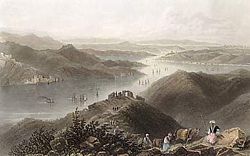
Byzantine Empire
The Byzantine Empire was the Eastern Roman Empire during the periods of Late Antiquity and the Middle Ages, centred on the capital of Constantinople. Known simply as the Roman Empire or Romania to its inhabitants and neighbours, the Empire was the direct continuation of the Ancient Roman State...
. Under the Palaiologos
Palaiologos
Palaiologos , often latinized as Palaeologus, was a Byzantine Greek noble family, which produced the last ruling dynasty of the Byzantine Empire. After the Fourth Crusade, members of the family fled to the neighboring Empire of Nicaea, where Michael VIII Palaiologos became co-emperor in 1259,...
dynasty during the decline of the empire, Yoros Castle was well fortified, as was the Rumeli Kavağı on the opposite side of the Bosporus. A massive chain could be extended across the Bosporus between these two points, cutting off the straits to attacking warships, similar to the chain across the Golden Horn
Golden Horn
The Golden Horn is a historic inlet of the Bosphorus dividing the city of Istanbul and forming the natural harbor that has sheltered Greek, Roman, Byzantine, Ottoman and other ships for thousands of...
which was used to defend Constantinople
Constantinople
Constantinople was the capital of the Roman, Eastern Roman, Byzantine, Latin, and Ottoman Empires. Throughout most of the Middle Ages, Constantinople was Europe's largest and wealthiest city.-Names:...
during the last Ottoman siege
Fall of Constantinople
The Fall of Constantinople was the capture of the capital of the Byzantine Empire, which occurred after a siege by the Ottoman Empire, under the command of Ottoman Sultan Mehmed II, against the defending army commanded by Byzantine Emperor Constantine XI...
by Sultan Mehmed II
Mehmed II
Mehmed II , was Sultan of the Ottoman Empire for a short time from 1444 to September 1446, and later from...
.
Byzantine
Byzantine
Byzantine usually refers to the Roman Empire during the Middle Ages.Byzantine may also refer to:* A citizen of the Byzantine Empire, or native Greek during the Middle Ages...
s, Genoese
Republic of Genoa
The Most Serene Republic of Genoa |Ligurian]]: Repúbrica de Zêna) was an independent state from 1005 to 1797 in Liguria on the northwestern Italian coast, as well as Corsica from 1347 to 1768, and numerous other territories throughout the Mediterranean....
, and Ottomans fought over this strategic fortification for years. It was first conquered by Ottoman forces in 1305, but retaken by the Byzantines shortly thereafter. Bayezid I
Bayezid I
Bayezid I was the Sultan of the Ottoman Empire, from 1389 to 1402. He was the son of Murad I and Valide Sultan Gülçiçek Hatun.-Biography:Bayezid was born in Edirne and spent his youth in Bursa, where he received a high-level education...
took the castle again in 1391 while preparing for his siege of Constantinople. It was used as his field headquarters during the construction of Anadoluhisarı
Anadoluhisari
Anadoluhisarı is a fortress located in Istanbul, Turkey on the Anatolian side of the Bosporus, which also gives its name to the quarter around it...
, one of the more important castles for the siege. In 1399 the Byzantines attempted to take back Yoros Castle. The attack failed, but the village of Anadolu Kavağı was burned to the ground. The Ottomans held the fortress from 1391–1414, losing it to the Genoese in 1414. The forty-year Genoese occupation lent the castle its moniker of Genoese Castle.
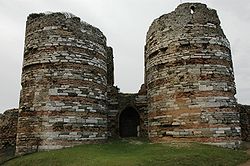
Bayezid II
Bayezid II or Sultân Bayezid-î Velî was the oldest son and successor of Mehmed II, ruling as Sultan of the Ottoman Empire from 1481 to 1512...
(1481–1512) later added a mosque within the castle walls.
Cossack
Cossack
Cossacks are a group of predominantly East Slavic people who originally were members of democratic, semi-military communities in what is today Ukraine and Southern Russia inhabiting sparsely populated areas and islands in the lower Dnieper and Don basins and who played an important role in the...
raids had plagued the Ottoman Empire throughout its long history. In 1624 a fleet of 150 Cossack caiques sailed across the Black Sea to attack towns and villages near Istanbul. They struck villages inside the Bosphorus, and Murad IV
Murad IV
Murad IV Ghazi was the Sultan of the Ottoman Empire from 1623 to 1640, known both for restoring the authority of the state and for the brutality of his methods...
(1623–1640) refortified Anadolu Kavağı to defend against the fleet. It would prove instrumental in the region from seaborne Cossack raids.
Under Osman III
Osman III
Osman III or Othman IIIText not available was the Sultan of the Ottoman Empire from 1754 to 1757.-Biography:...
(1754–1757), Yoros Castle was once again refortified. Later, in 1783 Abdülhamid I added more watchtowers. After this period, it gradually fell into disrepair. By the time of the Turkish Republic, the castle was no longer used.
Present Day Yoros Castle
The ruins of the citadel and surrounding walls still exist, though the mosque, most of the towers, and other structures are gone. Yoros Castle and the village of Anadolu Kavagi are a popular day trip from Istanbul. Typically, the site is not supervised and visitors are free to climb all over the ancient walls. However, there are currently archaeological excavations going on and visitors are unable to enter the castle. Greek inscriptions remain etched on the walls of the castle to this day, along with the symbol of the Palealogus family, who ruled ByzantiumByzantium
Byzantium was an ancient Greek city, founded by Greek colonists from Megara in 667 BC and named after their king Byzas . The name Byzantium is a Latinization of the original name Byzantion...
until its fall.
The military importance of the site cannot be overstated. In fact, much of the area surrounding Yoros Castle is today in the hands of the Turkish military
Turkish Armed Forces
The Turkish Armed Forces are the military forces of the Republic of Turkey. They consist of the Army, the Navy , and the Air Force...
, who have closed off areas to visitors.
Anadolu Kavağı
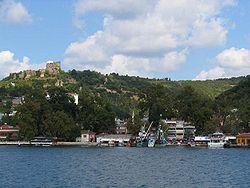
See also
- IstanbulIstanbulIstanbul , historically known as Byzantium and Constantinople , is the largest city of Turkey. Istanbul metropolitan province had 13.26 million people living in it as of December, 2010, which is 18% of Turkey's population and the 3rd largest metropolitan area in Europe after London and...
- TurkeyTurkeyTurkey , known officially as the Republic of Turkey , is a Eurasian country located in Western Asia and in East Thrace in Southeastern Europe...
- Byzantine EmpireByzantine EmpireThe Byzantine Empire was the Eastern Roman Empire during the periods of Late Antiquity and the Middle Ages, centred on the capital of Constantinople. Known simply as the Roman Empire or Romania to its inhabitants and neighbours, the Empire was the direct continuation of the Ancient Roman State...
- Ottoman EmpireOttoman EmpireThe Ottoman EmpireIt was usually referred to as the "Ottoman Empire", the "Turkish Empire", the "Ottoman Caliphate" or more commonly "Turkey" by its contemporaries...
- GenoaGenoaGenoa |Ligurian]] Zena ; Latin and, archaically, English Genua) is a city and an important seaport in northern Italy, the capital of the Province of Genoa and of the region of Liguria....
- Sultan Mehmed II

